
CHM3120L
Introduction to Analytical Chemistry: Laboratory
| Lab Schedule |
| LON-CAPA Pre-Labs |
| Resources |
| Contact Instructor |
| Chemistry Home Page |
![]()
Li by Flame Emmision: Introduction
The purpose of this experiment is to acquaint you with flame emission spectrometry. The determination of lithium, and all other alkali metals for that matter, is difficult by classical "wet chemistry" techniques, since they form no common insoluble salts and no complex ions with chelating agents. However, the determination of Li by flame emission spectrometry is simple and straightforward.
You are probably already familiar with the flame test for Na, in which the presence of a sodium salt is detected by the yellow color imparted to a flame when a small quantity of the salt is introduced. The process can be described as:
Na + heat -----> Na*
where Na* is an excited sodium atom. This is followed by
Na* ----> Na + hn
The net result is that thermal excitation is converted into emitted light. For Na this light has a wavelength of 589 nm; for Li, 670.8 nm. Observation of the characteristic wavelength of light emitted by the element is the basis for qualitative analysis. Measurement of the radiant power of the emitted light permits quantitative measurement of the metal ion content of the sample.
A flame emission spectrometry experiment consists of the following components.
- The sample is dissolved and the solution brought to an appropriate concentration, which is usually quite low. The sensitivity of the flame emission technique is very good, and by working at low concentrations non-linear behavior can be avoided.
- The solution is aspirated into a flame, beginning the following sequence of events:
- aspiration [fine droplets produced(nebulization)]
- evaporation of solvent
- decomposition to atomic vapor (atomization)
- thermal excitation of atoms
- emission of light.
- A filter or monochromator is used to isolate the light emitted by the element of interest from that emitted by other elements in solution and from elements of the flame fuels. Emission by molecules in the flame can be corrected for by employing a blank.
- The light that is isolated must be detected and its radiant power measured. A photomultiplier tube does this by producing an electrical current that is proportional to the radiant power striking it.
- This photocurrent, after suitable electronic amplification, is read on a meter. The reading is proportional to the concentration of the analyte in solution. The relationship between instrument response and concentration must be established by calibration of the system. Calibration is done by measuring the instrument response for solutions of known concentration.